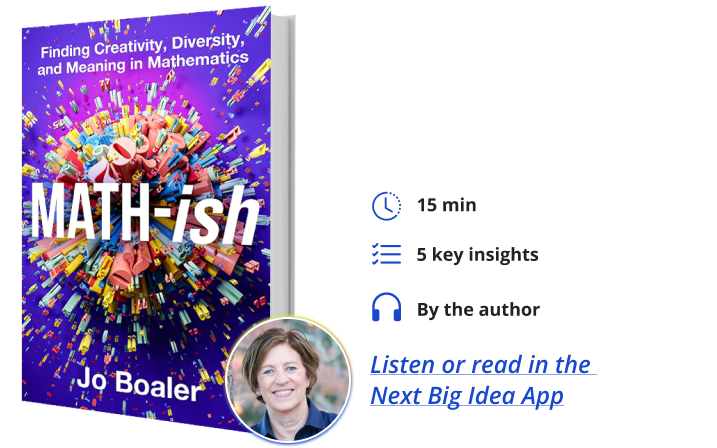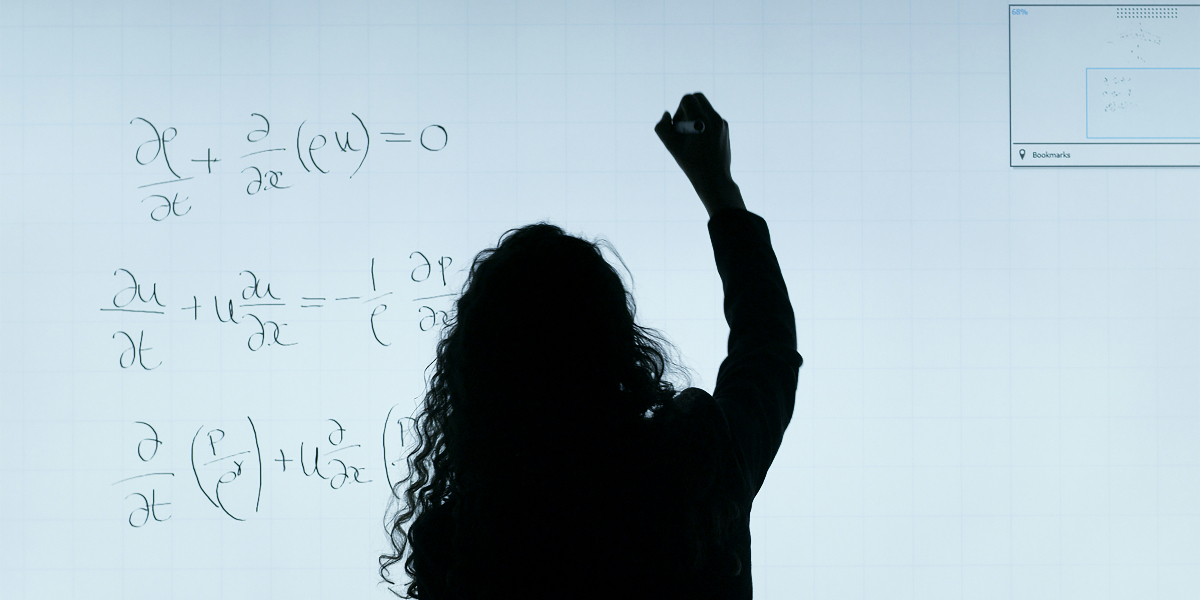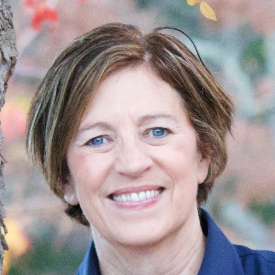Jo Boaler is a professor at Stanford University and co-founder of youcubed and Struggly. She is formerly the Marie Curie Professor of Mathematics Education for England, a mathematics teacher in London comprehensive schools, and a researcher at King’s College, London.
Below, Jo shares five key insights from her new book, Math-ish: Finding Creativity, Diversity, and Meaning in Mathematics. Listen to the audio version—read by Jo herself—in the Next Big Idea App.

1. Struggle and mistakes make our brains grow.
Before getting into any math, let’s explore some important ideas for approaching learning and life. Neuroscientists at Stanford are revealing fascinating insights into how our brains process math and other things. One of the most surprising and interesting facts is that struggling and making mistakes are the best times for our brains. As one neuroscientist said to me, “If you are not struggling, you are not learning.” Generally, though, people everywhere feel bad about times of struggle.
When I teach Stanford undergraduates, doctoral students, or school children, I share with them that mistakes and times of struggle should be celebrated! They are when our brains are on fire with connectivity, growth, and strengthening. Often, I also share with them the story of a famous mistake.
Fermat’s Last Theorem was named after a French mathematician, Pierre de Fermat.
We know in mathematics that 32 + 42 = 52. Fermat made a bold claim—he said that a similar expression could never work with an exponent higher than two, and he had a marvelous proof that it would never work—but he did not share the proof. This set mathematicians on a quest to find the proof for hundreds of years.
“There is value in mistakes and during the times when our brains are struggling.”
It was more than 350 years later that a proof was found by the English mathematician Andrew Wiles. Wiles chose to share his proof at The Isaac Newton Institute in Cambridge, England. Rumor had got out that Fermat’s Last Theorem may have been solved, and the room was packed with over 200 mathematicians and journalists. Wiles presented his work over three different lectures. When he finished, the room erupted into applause. Over the next few weeks, it transpired that there was a mistake in his proof, and Wiles went back to his study to work for a few more months before he came up with an accurate proof.
This is an interesting story in itself. It highlights that important mathematical work is not about speed, which is a critical message for people. Something else I always highlight is that the mistakes that Wiles put forward have now produced new fields of mathematics, including parts of algebra. As Peter Brown said, “Out of the ruins of these failures rose deep theories that opened up vast new areas of mathematics.”
There is value in mistakes and during the times when our brains are struggling. That is when brains are strengthening and growing. That message is important not just for students in school but for all of us and in all of our lives. When learning anything, you should want to be on the edge of your understanding, making mistakes, correcting them, and making more. That edge is where the greatest knowledge development and creativity happen.
2. The way you approach learning and life matters.
People think that if you are asked to answer a math question, or any kind of question, you either have knowledge or you don’t. But there is so much more going on in our brains. Successful people are not usually those with more knowledge; they have developed particular ways of working.
It all starts with metacognition. People think metacognition is thinking about your own thinking. Although that is part of it, there are actually four different aspects of m-cog. When we take them on, we become better problem solvers, communicators, and questioners. We become more motivated, develop better relationships, and become more successful in our jobs.
A person who has learned a metacognitive approach is likely to be inquisitive and curious, and they appreciate diverse viewpoints, which is so important in the world right now. Importantly, they enjoy the process of problem-solving and learning. This complex combination of high-level problem-solving, mindset, and planning occurs when we are metacognitive in the anterior prefrontal cortex of our brains.
The first aspect of metacognition starts with self-belief. That means you know you can solve the problem with effort and work because mindset is part of metacognition.
“It all starts with metacognition.”
The second aspect of metacognition is employing different strategies. These strategies include taking a step back and reading the problem out loud, drawing the problem, simplifying it, or trying a smaller case. Students in math classes are rarely taught these strategies, but they usually make the difference between being successful and unsuccessful with problems.
The third aspect is tracking progress. Metacognitive people think about what they have achieved and what they need to achieve. They may use journaling or sketch-noting, both of which help encourage metacognition.
Finally, and perhaps most importantly, a metacognitive person is self-reflective. They ask themselves why something works or is the way it is.
All of these metacognitive ways of being can be learned. If you take on these approaches when facing problems—in learning or life—you will be more successful, whatever knowledge you have.
3. Math-ish.
Numbers are everywhere in the world, and we all use them, in some form, every day of our lives. But there is something interesting about our everyday use of numbers, as in almost every number question we solve, we give -ish answers. For example: How much of the moon can we see tonight? How long is the drive to the airport? How old are you? How much rain fell last night? How many people live in the United States? How long is London Bridge? How much paint do I need to paint the wall?
Additionally, every shape in the world is an -ish shape; there is no perfect circle, rectangle, or square. But math classrooms are all about precision. About 80 percent of questions we answer in the world have -ish answers (that is an ish answer), but in classrooms, about 99 percent are precise. That is out of balance, and I urge us to get in balance.
Teachers everywhere say that students do not have a good sense of numbers, and they get lost in calculations with no idea of what the answer should be. A national standardized question gave 7/8 + 12/13 and asked people to estimate the answer. We know 7/8 is almost 1 and 12/13 is almost 1, so a good estimate would be 2.
They gave possible answers of 1, 2, 19 or 21. The most common answer from US 17-year-olds was 19, followed by 21. Students make those mistakes because they are never asked to -ish answers. They have not developed number sense, and they get lost inside manipulating numbers. When you -ish an answer, your brain stays at an important place. You think about the concept of a number, and you develop number sense.
There are other important reasons for -ishing answers. Many students and adults are afraid of math. What they are afraid of is being wrong. Asking students to -ish numbers releases them from that fear. I have seen that in classrooms and videos on my Mathish website. Teachers ask students for their -ish answers, and hands go up all over the room. Even the shyest and most disengaged student is willing to share their -ish answers.
“About 80 percent of questions we answer in the world have -ish answers.”
I propose that before any student or person works on a calculation or mathematics problem, they think about the answer and come up with an -ish answer. This isn’t limited to number questions either. Before drawing a graph, try to imagine what it will look like. It will cause your brain to pull back from the detailed focus and move into a different mode, thinking conceptually, which is really important.
Some people ask me how asking students to -ish numbers is different from asking them to estimate. They are the same thing, but with an important language change. When we ask students to estimate, they think they are being asked to perform another mathematical method. Often, they calculate precisely and round it off to make it look like an estimate. But when we ask students to -ish numbers, they feel free. They are more willing to share their ideas and, at the same time, develop a number sense.
Taking an -ish perspective is freeing in many parts of life and it does something important for your brain. As you go about the world to -ish numbers, you will not only feel freer, but you will be doing something really important for your brain.
4. We can learn better through mathematical diversity.
The way we all function in the world is by making mental models of it. For example, if I asked you to think of a stapler, you can probably think about what one looks like, the sound a stapler makes, the feel of a stapler in your hand, and the way a stapler changes when you interact with it. Your brain has built a model of a stapler, which is stored in your neocortex, a large and important part of your brain.
It turns out that when we learn, we are helped by building mental models of ideas. Your brain returns to these models when it needs to use knowledge. There are parts of your own learning where you built rich mental models that you can still use and remember. Anything in math can be learned as a visual or physical model that students can see, feel, move around, and interact with.
When you learned about square numbers and square roots, did you draw and build squares and feel them? Did you move them around in your hands? When you considered square roots, did you physically or visually find the diagonals of squares? When you learned about cube numbers, did you build cubes? Did you touch and feel them to see their features and build a mental model of what it means to be cubic? It is likely that you didn’t, so you probably did not develop the mental models you needed. You probably just have a few memories of numbers. Everything can be experienced visually and physically, including algebra.
Neuroscience also tells us we have five brain pathways that can be used when thinking about math. At the back of our heads are two important visual pathways. The most successful people in the world are those who have more communication between different brain pathways. They have interconnected brains. These interconnections build when we don’t just experience math as numbers, but we see it visually, build it, move to show the ideas, and use words to describe it. Interconnections happen when we experience math multidimensionally.
5. Math has a rich cultural history in the world.
Few people learn about the history of numbers, but if they did, they would learn that the first quantitative records in the world came from the Brazilian Amazon. Paintings, created by Indigenous artists more than 10,000 years ago, show “x” marks, counting days, moons, and other cycles. The ancient people of Brazil were paying attention to quantities, now thought to be the first prehistoric numerals.
“These decisions have remained and are why we have 12 hours in a day.”
In a small Congolese area of Africa, a bone was found that has fascinated historians over the generations. It is called the Ishango bone, and it has deep mathematical significance. The Ishango bone is considered to be 20 millennia old and has a set of markings that reveal awareness of prime numbers and the decimal system. The first indications of these important parts of our number system came from central Africa.
Sumer is the earliest known civilization that lived in the region of what was called Mesopotamia, now “the land between the rivers” in Iraq. Later, the Babylonians lived in the same region, and it is the Sumerians and Babylonians who are credited as being the first users of algebra. The word algebra comes from the Arabic: Al-Jabr, meaning the reunion of broken parts. Moving through time, the number system we know and use in the West comes from the Arabic system, which, in turn, came from the Indian system. Scholars in India invented the number zero.
One of the first uses of numbers is shown in the recording of time. People wonder why our system of recording time is in units of 12 or 24 (hours) and the answer is that it comes from the ancient Egyptians, who developed sundials more than 3,000 years ago. The decision to divide the day into 12 units came from the shade they could see on sundials. They saw 10 units from sunrise to sunset and then added a unit for dawn and another for twilight. These decisions have remained and are why we have 12 hours in a day.
When we look at the rich cultural history of mathematics, we see mathematical diversity – as mathematics itself is beautifully diverse. It draws from the rich diversity of people across the world, and it is part of our culture.
To listen to the audio version read by author Jo Boaler, download the Next Big Idea App today:
































